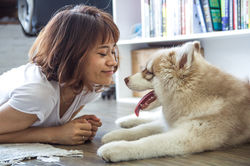Compete in the 2018 World Cynosport Games With Your Furry Athlete
- Taylor Timinskas
- Apr 6, 2018
- 2 min read
Updated: Apr 12, 2018

The USDAA hosts the annual World Cynopsport Games for Dog Agilities, and the qualifying rounds are starting soon near you! Does your dog have what it takes to compete for the top prize of ten-thousand dollars?
If you are not familiar with the dog agility sport, the clip below covers the 2018 Master Agility Competition:
Regular competitors know that this year marks the thirtieth annual year of this prestigious competition. While the best of the best have already started practice, it is not too late to test the waters with new competitors. Dog agility is the fastest growing dog sport right now, and many new teams are coming to join both local, regional, and national events in preparation for this competition. This event has the common agility obstacles such as weave poles, A-frame, dog walk, see-saw, tunnels, and different kinds of jumps and hurdles (Cynosport). Of course, the fastest your dog finishes the course, with account for faults, the better they will do in the competition. To enter your dog, you must sign up for a specific height class ranging from twelve inches to twenty-six inches. Then you will be required to compete in qualifying rounds that will be somewhat local to where you live, creating a perfect way to introduce you and your dog to the sport. Please visit USDAA Dog Agility’s office website for more information and an introduction to training your dog.
Why is the world of dog competition so important to dog owners?
Through a new psychological study conducted by Jocelyn Farrel of Lakehead University, a group of participants in dog-sports was analyzed. From the group, the competitors were mostly female at eighty-percent of the population, seventy-eight percent were in the age range of forty-five to seventy-four years, and at least eighty-there percent of the individuals obtained some form of higher education (Coren). These people are typically well-enough off to deals with the costs of travel and training and are also able to give the time commitment. From the study, the motivations for these dog-owners to compete in dog sports was distinguished in “external motivation” and “internal motivation” categories (Coren). External motivation meant that the subject competes because of the potential awards from winning or showing off their dog. Internal motivation, on the other hand, means that they compete for the experience and doing a productive activity with their pet. Most of the competitors fell into the internal motivations section with the main goals of better connection with their dogs, social aspects of participation for both themselves and their dog, enjoyment, opportunity for physical activity with their dog, and the satisfaction of working together with their dog (Coren). Overall, people in dog-competitions don’t just compete to exploit their dogs for money, but rather do it because it’s a way for them to explore their bonds with their dogs in a new, challenging way. So if you are considering trying out this sport with your dog, go for it!
Works Cited:
Coren, Stanley. “Who Participates in Dog-Sporting Events and Why?” Psychology Today, Sussex Publishers, 26 Mar. 2015, www.psychologytoday.com/us/blog/canine-
corner/201503/who-participates-in-dog-sporting-events-and-why.
“Dog Agility Competitions.” Cynosport World Games, United States Dog Agility Association, 25 Jan. 2018, www.cynosport.com/dog-events/.
















Comments